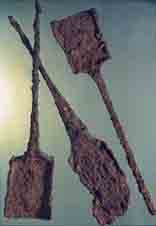Image Details

Courtesy Avraham Biran
During the Reign of King Jeroboam II in the eighth century B.C.E., the royal bamah continued to flourish as a place of worship. Biran discovered two long chambers, called leshakot (“offices”; singular, lishkah), that date to this period. One lishkah contained a stone altar and a number of artifacts associated with it: a jar filled with ashes, two incense altars, a bronze scepter head and three iron shovels used to scoop coals. Biran has identified the shovels, which measure a little over 2 feet long, as Biblical machtot (singular, machtah). Similar shovels, although with shorter handles, are depicted in synagogue mosaics dating to the Roman and Byzantine periods.
